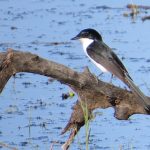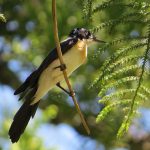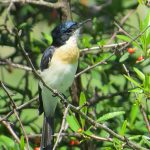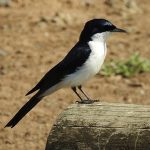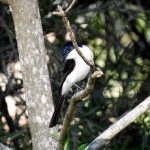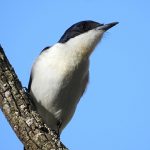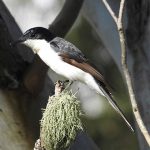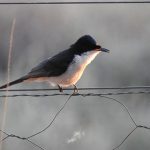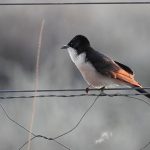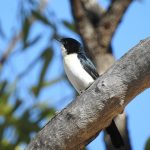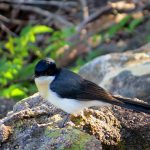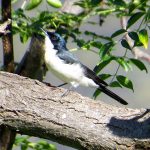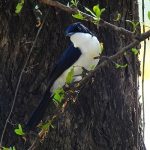RESTLESS FLYCATCHER
The Acrobat of Australia’s Open Woodlands
Among the tapestry of Australia’s birdlife, the Restless Flycatcher stands out for its enchanting mix of energy, elegance, and ecological importance. With its active movements and melodious call, this bird weaves an unforgettable presence throughout much of the Australian mainland.
Visual Description
Imagine a bird about the length of an adult’s hand — 18 to 20 centimetres from beak to tail. Its plumage presents a classic contrast:
- Upper body: A cloak of deep slate-grey feathers gives it a distinguished appearance.
- Underparts: Bright white, traced with soft black streaks, especially along the sides.
- Face: A fine, dark mask surrounds clear, alert eyes, while both bill and legs are a sleek, glossy black.
Close your eyes and you might picture it poised on a branch, the sunlight catching the subtle shimmer of its wings.
Habitat and Distribution
Restless Flycatchers thrive in diverse landscapes, choosing locations where scattered trees mingle with broad grassy patches. Listen for them in:
- Open woodlands,
- Dry eucalypt forests,
- Lightly timbered scrublands.
They are endemic to Australia, found almost everywhere except for:
- The arid heart of central Australia,
- Lush, closed-canopy rainforests in the north-east.
Their presence is often signalled by movement: flicking wings and tails as they dart from perch to perch.
Behaviour: A Study in Restlessness
The name “Restless Flycatcher” speaks volumes about this species’ personality.
- Constantly on the move, they exhibit a springy energy, flicking their wings and tilting their tails.
- Watch as they sally out from low branches, snatching insects from the air with remarkable agility before returning swiftly to their vantage point.
- Their call — a repetitive, high, “si-wee” or “see-see” — hangs in the air, delicate yet commanding.
Auditory Experience: Imagine the gentle rustling of leaves and the bright, sharp notes of the Restless Flycatcher echoing above the hum of summer insects.
Diet: Champions of Insect Control
These birds are valuable natural pest managers, relying chiefly on:
- Flies,
- Beetles,
- Ants,
- An array of other flying insects.
With keen eyesight and acrobatic skill, they launch from perches to intercept their prey mid-flight, contributing quietly but significantly to balancing local insect populations.
Nesting and Family Life
Breeding commences as the weather warms in spring and summer.
- Nest: A neat, cup-shaped structure woven from grass, bark, and fibre, usually secured in the fork of a branch or along a sturdy horizontal limb.
- Incubation: The female takes the lead, keeping the eggs safe and warm.
- Raising Chicks: Once hatched, both parents join forces, sharing the duty of bringing food to the hungry chicks.
Imagine the gentle sway of a nest in the dappled light, parents meeting and parting, ever-vigilant and nurturing.
Ecological Role and Conservation
The Restless Flycatcher is a keystone species in many of its habitats. By preying on flying insects, it helps support the delicate balance of woodland ecosystems. Its presence indicates a healthy blend of open and sheltered environments — landscapes increasingly under pressure from land clearing and habitat change.
Conservation Message
While not currently threatened, the Restless Flycatcher reminds us of the importance of preserving diverse habitats — not only for their gleaming flight but for the quiet, intricate work they do as part of Australia’s ecological web.
Quick Facts Table
| Feature | Details |
|---|---|
| Length | 18–20 cm |
| Plumage | Dark grey (upper), white with black streaks (under) |
| Distinctive mark | Thin black eye mask |
| Habitat | Woodlands, forests, scrublands, open spaces |
| Distribution | Most of mainland Australia |
| Diet | Insects: flies, beetles, ants, etc |
| Breeding | Spring–Summer, cup nest in trees, biparental care |
Conclusion
Observing the Restless Flycatcher is to witness the lively spirit of Australia’s wild landscapes. Each dart, each shimmering flight, and each melodic call reminds us of the intricate links within nature. Through understanding and appreciation, we are inspired to protect not just this remarkable bird, but the living tapestry it inhabits.
When you next wander through an open woodland, take a moment to listen — the clear “see-see” of the Restless Flycatcher may just draw your gaze upward, inviting you to marvel at nature’s dynamic artistry.

